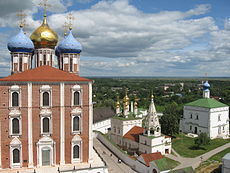 Former Kremlin, Cathedral of the Assumption | ||
| Ryazan | ||
| Oblast | Ryazan | |
|---|---|---|
| Residents | 537.622 (2017) | |
| height | 130 m | |
| no tourist info on Wikidata: | ||
| location | ||
| ||
Ryazan (Ряза́нь) is the capital of the oblast of the same name and is located approx. 180 km southeast of Moscow in Central Russia.
background
Ryazan is located on a hill on the right bank of the Oka River, not far from the southern end of the national park Meshchora. With over 500,000 inhabitants, it is one of the largest cities in Central Russia. Ryazan was founded around the 11th century and was called Pereyaslavl until 1778. Until the 17th century it was part of the strategically important line of defense on the southern borders of the Moscow principality. As in several other cities on the Oka, a powerful Kremlin, an old Russian citadel, was built here, which was supposed to protect the Moscow state from possible attacks from the south. From the 18th century, Ryazan lost its importance as a fortress, instead trading developed here and since the 20th century Ryazan has also been an important industrial city.
getting there
By plane
Although Ryazan has two small airports, these currently hardly play a role in civil air traffic. From abroad, Ryazan can only be reached via Moscow airports. From Moscow Domodedovo Airportwho, inter alia. is served by Lufthansa, a direct bus runs several times a day to Ryazan.
By train
Ryazan has two main train stations 1 Ryazan-1 and 2 Ryazan-2. One of the ways to get there from Moscow is local trains that run from Kazan train station depart. The journey time is a good three and a half hours.
By bus
In the street
By boat
mobility

Tourist Attractions
- 1 Kremlin. The most famous sight of Ryazan is the Kremlin Moscow, Tula or Novgorod) no fortifications have been preserved. Today you can find some remains of old earth walls as well as parts of the ensemble that was once built inside the citadel, which includes several churches from the 15th-17th centuries. Century (including the Assumption Cathedral). The historic city center is well worth seeing, the strictly geometric street network of which was built at the end of the 18th century. You can find historical two- to three-story houses from that time as well as some wooden houses. Some of the larger streets are characterized by "Stalinist" architecture from the early post-war period.
activities
shop
kitchen
nightlife
accommodation
security
health
Practical advice
trips
literature
Web links
- http://admrzn.ru/ - Ryazan's official website

